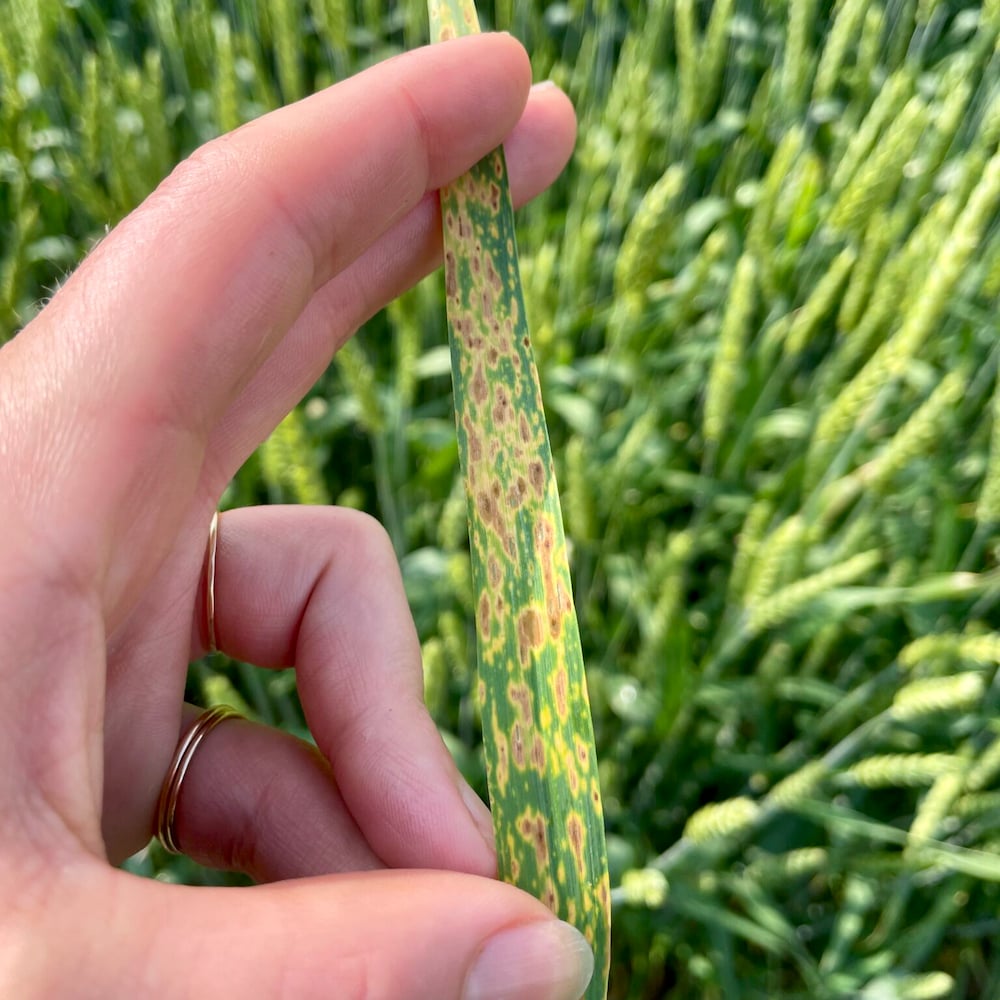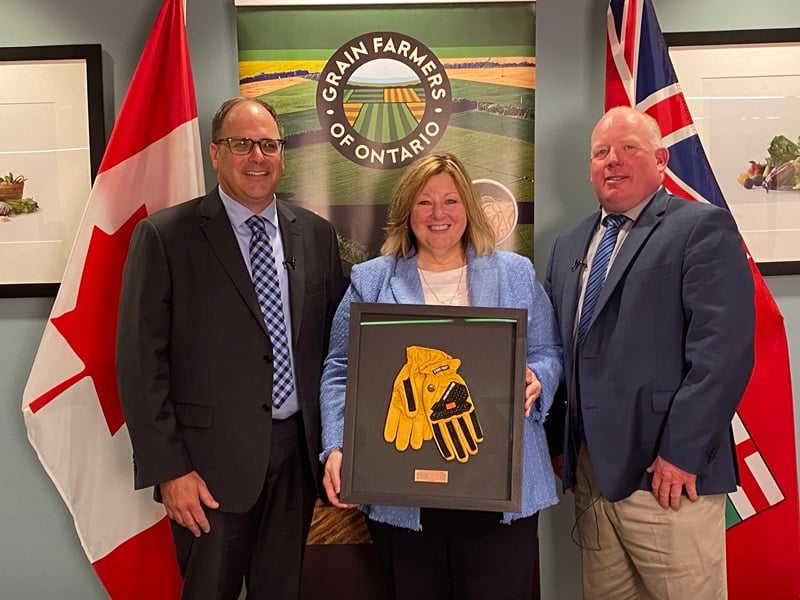Field conditions in Ontario seen as ‘frustrating’

It continues to be a frustrating spring for field conditions through much of the province. Frequent precipitation has continued to cause delays in tillage, planting, and spraying in some areas, and weather earlier this week has shut down field work once again in many areas.
Read Also

GFO presents province with Gloves of Gratitude
Grain Farmers of Ontario recently awarded Ontario Ministry of Agriculture, Food and Rural Affairs Minister Lisa Thompson and the Ontario…
However, with 3–5-day windows of good weather, many producers have covered a lot of ground in a short time, especially on lighter soils that have avoided heavy rainfall. Farms on heavier clay soils continue to face difficulties, but there is still time to get crop in the ground.
Cereals
Wheat growth and development continues to be more advanced than normal, with most of the winter wheat in the province either close to or fully headed out. Overall, the crop continues to look good, and yield potential looks strong.
Stripe rust has been in several locations throughout Ontario. This disease is critical to control, especially in susceptible varieties where it can cause major yield loss. Its arrival may complicate T3 fungicide application in fields that have not yet reached optimal timing for fusarium head blight protection and DON reduction. Stripe rust is a fast-moving disease and has the spread through a field within a few days. Scouting is an absolute must ahead of T3 fungicide application. See the Ontario Cereal Crop Committee performance trials at gocrops.ca or check with your seed supplier for ratings for both stripe rust and fusarium head blight to prioritize action if necessary.
There have been some incidents of surfactant injury reported from T3 fungicides. Often the problem looks worse than the yield loss that can occur. Physiological fleck (see photo at top) is also
appearing in several fields, and the two can be misidentified as well as confused with disease symptoms.
Root rots diseases are also appearing due to wet conditions and can be confused for viral infections or other disease as well. Lodging is likely to be a concern through the grain fill period. Heavy plant biomass due to good growing conditions this spring has already led to some small areas of lodging in fields, particularly in hollows with high yield potential. Varietal differences in lodging score may be of importance to prioritize harvest in the coming weeks.
Forages
Harvest of triticale and rye is wrapping up, while first cut of alfalfa has started. Yields have been excellent so far, but quality has been difficult to manage as rains have delayed cutting past the optimum stage, or the cut crop has gotten rained on.
Alfalfa weevil populations are very high in some fields. Control may be necessary if populations are high and harvest is more than a week away. See the Crop Protection Hub for details on registered products for control.
Forage gas poisoning is a threat that exists with the early start to ensilage season. One incident has been reported already, it’s important for producers to keep this in mind and not be working alone where the threat exists.
Corn
Corn planting is likely around 80-90 per cent complete across the province, although this number varies drastically depending on local conditions.
Some areas have planted very little of their intended acres, although there remains time in many locations for a successful corn crop. In longer season areas in the southwest, agronomists are recommending continuing to plant corn on intended acres rather than switch to soybeans, especially in fields that have had continuous soybeans for several years in a row.
Corn planted earlier in the spring is up and looking very good, with some of the earliest crop at the 5-leaf stage already. Crop planted in the last couple of weeks has enjoyed rapid emergence due to warm soils, out of the ground within 4-5 days in some cases.
Some fields with emerged corn remain weedy as sprayers have had trouble covering acres this spring. Data from Peter Sikkema at the University of Guelph – Ridgetown Campus has shown that in fields with high weed density, that yield losses of 1.7 bu/ac per day can occur for every day that control is delayed past emergence. Timely control of weeds is crucial right from emergence in corn.
Soybeans
Soybean planting is highly variable across the province as well, with some producers having yet to plant an acre, and producers in drier areas having completed planting. Estimates for planting progress across the province is in the 50-70 per cent range.
Changing varieties is not necessary unless planting is delayed into July. Full season soybean maturity recommendations are conservative in Ontario and allow for later planting. The main reason to not switch to shorter maturing varieties is that shorter maturing varieties have lower yield potential. A reduction of one full maturity group (1.0 MG) will drop yield potential by about 5 bu/ac. If the field is intended for winter wheat a shorter maturing variety has likely already been selected to facilitate timely wheat seeding. If seeding wheat this fall is an absolute priority a further reduction may be warranted if soybean planting is delayed past June 15th. In the relative maturity grouping system used for soybeans each decimal place represents a 1-day delay in maturity in the fall. For example, a 1.5 MG variety will mature 4 days earlier than a 1.9 MG when seeded on the same day. Weather conditions will influence the exact difference in maturity but generally speaking a 0.5 MG shorter maturing variety than a full season is considered adequate for timely wheat seeding.
Soybeans have begun to emerge as well, with some already in the 1st trifoliate stage. Due to warm temperatures and moisture, soybeans have emerged rapidly.
In some cases a mix of warm temperatures and rainfall have caused producers to miss pre-emergent herbicide applications. In fields with heavy weed pressure, this limits the products available to control large weeds to prevent yield loss. IP soybean producers who miss pre-emergent herbicide applications will be severely limited with product choice.
Agronomists are recommending that pre-emergence herbicides are absolutely critical to control weeds in soybeans, and should be done prior to planting if there’s a chance of missing the application window post-planting. When dealing with problem weeds such as glyphosate-resistant Canada fleabane, there are no good post-emergence herbicide options for control in IP soybeans.
Edible beans
A small number of acres have been planted, but the majority of intended edible bean acres are still to get in the ground. There has been increasing interest in acres overall, and some producers may end up switching fields from corn to edible beans if delayed much further.
Herbicides
As weeds get larger, they become much harder to kill. Correct product and rate selection becomes critical as management plans are adjusted based on weed type, density, and size. Use of highest labelled rates is recommended with larger weeds. With higher weed density, it becomes more important to maintain good coverage with herbicides, which may involve using higher water volumes, slowing the sprayer down and lowering the boom closer to the target.
With post-emergent applications especially, a reminder from agronomists that with more products added to a tank-mix, there is a greater chance for crop injury from the herbicide, in many cases without an increase in weed control. Adjuvants are important for use with certain herbicides, but care should be taken to ensure they don’t cause injury from improper use. The Crop Protection Network has provided some excellent guidelines for proper adjuvant selection and use, located here.
As a general reminder, only use registered products with labelled rates and tank-mix partners for weed control in Ontario. Some product active ingredients are registered in the US, but often with different formulations and rates that can cause crop injury on this side of the border. Always read and follow label directions!
Agricorp report
For Production Insurance coverage, crop planting deadlines are June 15th for corn, and June 30th for soybeans. The deadline for reporting unseeded acreage is June 15th, and deadline for reporting actual acres of spring-seeded grains and oilseeds or new forages is June 30th. Report acres as soon as possible to avoid busy times at the deadline.
– To read the full Ontario Crop Report for May 30 , visit the Field Crop News website.
Source: Farmtario.com

